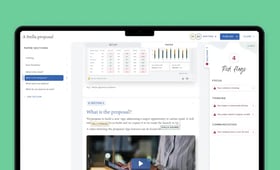A great board pack is both the stimulus for the boardroom conversation and a record of good corporate governance. How can your boards pack help promote and evidence an effective board?
Why board packs are central to good corporate governance
Board packs are the primary source of information that enables directors to fulfill their duties. An effective board pack will:
- Support better board decision-making and strategic oversight.
- Help directors prepare, and make better use of board meeting time.
- Ensure accountability and legal and regulatory compliance.
- Enable effective risk management.
The role of board packs in decision-making
A good board pack helps the board make the right decisions, at pace, and provide effective guidance for management. It does this by:
- Providing a comprehensive overview of how the organisation is performing, its objectives and strategic priorities.
- Bringing directors up to speed so they can prepare well for board discussions and make best use of board meeting time.
- Presenting data and reports clearly, drawing out the ‘so what’, the options and recommendations.
How board materials support accountability and transparency
Board materials and minutes are the permanent record of decisions, their rationale, and who is responsible for what happens next. They help demonstrate accountability and transparency by:
- Evidencing due diligence and due process. They help to show board engagement, their rationale on key decisions, and provide a record of conflicts of interest.
- Enabling performance tracking. Financial, operational, and strategic reports show whether management is delivering against the agreed strategy. Without it, the board can’t hold anyone accountable.
- Keeping momentum between meetings. Clear action items assigned to specific individuals with clear deadlines help maintain accountability between meetings.
What good governance looks like
1. Focused board input
Too many boards get bogged down in the same old topics without considering what their organisation needs right now. And, all too often, managers see the board more as a rubber stamp than a wealth of skills and experience to draw upon.
Effective boards are focused boards. They identify their priorities annually, considering the wide breadth of their role and the needs of their organisation. Their board calendar allocates time to these priorities, as well as the routine items and the unforeseeable ones. Similarly, board papers should clearly specify the input required from the board. Stating whether a board paper is to note, to discuss, or for a decision, is a good start, and management can go further, for example requesting the board’s advice on a specific approach or outlining the implications of delaying a decision.
2. Clear, relevant information
Board papers should be clear, well structured, concise, and compelling. This includes organising information in a logical structure that is easy to navigate, with a clear and consistent format, and relevant section headings - structured in question and answer format. Data visualisation alongside clear narrative can also be helpful for directors interpreting complex information.
Read more: how to communicate clearly in your board paper.
3. Key messages upfront
Many board reports start with a general introduction to the topic, making the reader wade through multiple pages before they see the focus of the paper. This is not helpful for the time-poor director moving between different topics as they navigate through the board pack. To avoid this, begin every board report with an Executive Summary that provides a snapshot of the whole report. This ensures that the reader can see the key messages, helping them to prepare for the board meeting.
Read more: how to write an executive summary for your board.
4. Balanced reporting of risks and opportunities
A well written board paper doesn’t focus on good news alone. Challenges and risks should be given the same attention as successes and opportunities, presenting a well-balanced picture of the organisation to the board.
5. Forward-looking insights, not just backward-looking data
It’s important that the board looks forward, as well as reviewing past performance. Board packs can encourage future-focused thinking by including:
- Sections on the future outlook and recommended course of action
- Analysis of best-case and worst-case scenarios
- Leading indicators of success or concerns
- External insights, including competitor analysis, market intelligence, and consumer or employee insights.
6. Clear discussion outcomes
Board minutes are not the only place to record the outcomes of board discussions. Nor are minutes the right place to track the progress of board actions or delegations.
Board packs should include an Action Tracker to record the progress of actions agreed, separating outstanding actions from in-progress and completed ones. Where the board has delegated discussions to committees, a concise update report on the outcomes of these is vital. Instead of committee minutes, a concise update report can be used. This can simply highlight the meeting agenda items, key discussion points and any agreed actions.
Need help embedding this approach with your board? Get in touch.
Common board pack issues that can undermine governance
Common board pack pitfalls that impact corporate governance include:
- Too much information, too little insight.
- A lack of strategic focus or context.
- Too much focus on historical performance and not enough on the future outlook.
- Missing key performance indicators (KPIs). A good KPI dashboard should include financial, operational, and strategic metrics.
- A lack of clarity about what is asked back from the board, for example a decision, a discussion, or simply noting information.
Information overload and noise
Overly long and dense board packs make it difficult for directors to extract key takeaways and focus on the most important points. Faced with hundreds of pages, directors may simply skim the content and miss critical details, which leads to surface-level discussions instead of strategic debate.
The average board pack is around 288 pages long, but the average board director spend around three hours reading their packs, and can read around 30 pages per hour. The more concise we can make papers, the more time directors have to engage. A good board paper should be no more than three to five pages.
Lack of focus on strategy and outcomes
A weak board pack might have lots of information about the organisation, but if it doesn’t focus on the right strategic outcomes, it undermines the board's ability to provide effective supervision and steering. If a board pack focuses too much on operational detail and not enough on strategy and outcomes, the board's attention will be distracted from what matters, leading to strategic drift and poor decision-making.
Failure to address risks or “bad news”
If a board pack only contains the good news, the board doesn’t get the critical information needed to make informed decisions and fulfill its fiduciary duties. Without an accurate view of internal and external threats, the board lacks strategic oversight, which leaves the organisation unprepared for changes and challenges.
Failure to disclose bad news can also be a sign of a corporate culture where management fears the consequences of reporting problems. This can create a pattern of misinformation and discourage people from speaking up about important issues. These unaddressed risks can turn into unexpected issues or risks.
How to ensure your board pack supports good corporate governance
In order to effectively support strong corporate governance, board pack content should:
- Align with the organisation’s goals and priorities.
- Ask meaningful questions.
- Present information clearly and concisely.
This gives directors what they need to understand the issues, opportunities, and risks presented in the pack.
Align reports with organisational goals
All reports included in the board pack should be clearly linked to the organisation’s strategic objectives. This helps directors focus on the most important points without getting lost in operational details. The board can better assess whether the organisation is making progress towards its goals and make decisions that help keep it on track.
Use structured questions to guide content
When briefing board reports, structuring it around key questions on the board’s mind can help guide report writers to provide the right level of details. Questions like, “What decisions are required?” or “What risks must be considered?” keeps unnecessary information to a minimum and sharpens the board’s focus on key issues.
Present data and insights in a digestible format
Don’t overwhelm the board with lengthy content and complex data. Where the information is complicated, use summaries and visual aids like dashboards and charts to help draw out the critical points and insights.
The benefits of good board materials
A board pack that enables oversight and good governance will improve the organisation’s efficiency and alignment overall by driving better decision-making, accountability, and oversight.
Stronger board discussions and oversight
A good board pack shifts the board's focus from operational particulars to high-level governance, risk, and long-term strategy. This improves corporate oversight as leaders have the information they need to make informed decisions.
Increased trust among stakeholders
Transparent reporting assures all stakeholders, including investors and regulators, that the company is being properly and ethically managed.
Better long-term decision-making
Good board materials support decision-making by providing:
- Actionable insights.
- Improved agility.
- A focus on future strategy.
A governance-focused board pack ensures that meeting time is spent on meaningful discussions and decisions, not catching up on details.
FAQs
-
What should a good board pack include to support effective governance?
An effective board pack is a collection of relevant documents that highlight important issues, risks, and opportunities to guide productive discussion. These include:
- Meeting agenda.
- Executive summary.
- Financial reports.
- Operational and strategic updates.
- Risk and compliance reports.
- Previous meeting minutes with action items.
- Proposals and resolutions.
-
How can poorly written board packs harm corporate governance?A weak board pack puts the organisation in danger of making poorly-informed decisions, missing critical risks, diminishing director accountability, and losing stakeholder trust.
-
What is the difference between operational detail and governance insight in board packs?
- Operational detail discusses the day-to-day business operations, i.e., the “what?” and “how?”.
- Governance and strategic insight offers a deeper understanding, with information needed for future direction, i.e., the “why?” and “so what?”.
-
How often should board packs be reviewed for alignment with governance best practice?Yes, software like a cutting-edge board portal can improve board pack quality and support better corporate governance by enhancing security, streamlining meeting preparation, and improving accessibility and collaboration.
-
Can board software improve the quality and governance value of board packs?Yes, software like a cutting-edge board portal can improve board pack quality and support better corporate governance by enhancing security, streamlining meeting preparation, and improving accessibility and collaboration.



